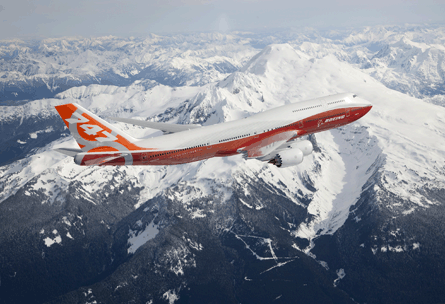Boeing's test pilots were able to push its 747-8 Intercontinental harder and higher than originally planned on its 20 March first flight thanks to more than 2,000h of test flights already logged on its freighter variant since February 2010.
The 4h 25min flight over Washington state took the aircraft, RC001, to 6,100m (20,000ft) and 250kt (463km/h) as it looks to complete a certification programme of around 600h.
"It's one of the cleanest first flight airplanes of a new design that I've seen and it just went perfectly," says 747 chief pilot Capt. Mark Feuerstein, who was at the controls with Capt Paul Stemer.
Feuerstein says the aircraft experienced roughly half-a-dozen maintenance squawks, none of which would prevent any 747-400 crew from dispatching the aircraft again. "The airplane is actually ready to go fly right now," he says.
 |
|---|
© BoeingMaiden sortie of passenger version of airframer's jumbo jet 'went perfectly' |
The aircraft took off from Runway 34L at Paine Field in Everett, Washington at 09:59 with an approximate rotation speed of 160kt at flaps 20, beginning its maiden sortie with a slow turn to the west along the Olympic Peninsula "keeping the airspeed fairly slow below 230kt, looking at the handling qualities of the airplane with the gear and flaps down, that's a very typical start to the flight," says Feuerstein.
When the aircraft neared the Pacific coast, it turned eastbound, followed by the first raise of the landing gear and flap retraction. It "took a little detour" for air-to-air photography in front of nearby Mt Baker, he adds.
Following its photo work, RC001 moved toward central Washington "where we do a lot of our stability and control work. From about [20,000ft] to 10,000ft we did simple approaches to stalls, a couple of directional stability conditions that looked at how the airplane turns and how straight it flies, then we continued some basic functional checks of the systems of the airplane to make sure that it all works properly," says Feuerstein.
Feuerstein and Stemer took advantage of the aircraft's maturity allowing them to "pull some tests forward", such as steady heading side-slips and turning approaches to stalls down to 105kt. Additionally, the stability augmentation was deactivated on the aircraft "to see what the bare airframe behaved like and it was absolutely phenomenal.
"It was kind of fun actually to do that so early in the programme," says Feuerstein.
The maturity of the aircraft's systems comes from the work already done on the 747-8F, adds Feuerstein: "It was the first opportunity for Paul and I to get a look at all of those changes rolled together into the one airplane. Because on the freighter fleet, each airplane is a little bit different. Today, we actually got an early look at what the freighter is going to look like when it's finished and it looks great."
The aircraft landed on Runway 31L at Boeing Field in Seattle at 14:24, where it will be based for the flight-test campaign.
RC001 will focus its time in flight test conducting flutter clearance, flight controls, ride quality and stability and control evaluations, building on the work it began on first flight. Flutter clearance is among the most important tasks for the aircraft as it is structurally different from the freighter, with an elongated upper deck and horizontal stabilizer tanks, which hold an additional 12,500 litres (3,300USgal) of fuel.
Boeing expects RC021, the second test aircraft, to join the flight-test programme in April. Its purpose will be to certificate aircraft's interior, including the galleys, lavatories, smoke penetration and environmental control system.
According to programme sources, the aircraft included items already tested separately on different 747-8 freighters, such as an updated flight management computer, refined nose landing gear wheel-well structure, strengthened inboard aileron power control unit, reinforced landing gear support structure, and new outboard main landing gear doors and inboard trailing edge flap modifications.
Source: Flight International























